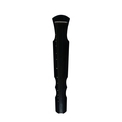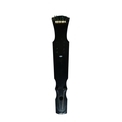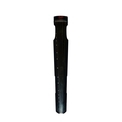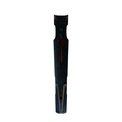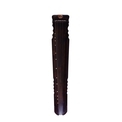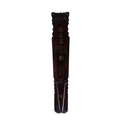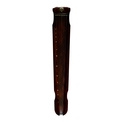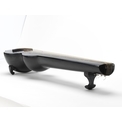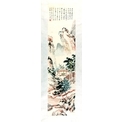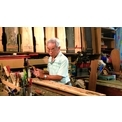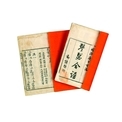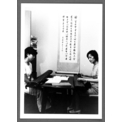The fifth step of qin making process: assembling
The chopped and hollowed top board and bottom board can be held together with a mixture of raw lacquer and flour, or with animal gum. After the boards have adhered to each other, a linen cloth can be glued onto and wrapped around the qin body, using an evenly applied layer of a mixture of raw lacquer and flour. This helps tightening the qin body and prevents the lacquer on the qin top from warping and cracking. Another way of assembly is to use bamboo nails to hold the top and bottom boards together at the corners of the forehead, the shoulders, the wings, the waist and the tail. The bamboo nails are inserted from the bottom upward. No adhesive is involved with this method. This photo shows the fifth step of qin making process which was demonstrated by Choi Chang-sau.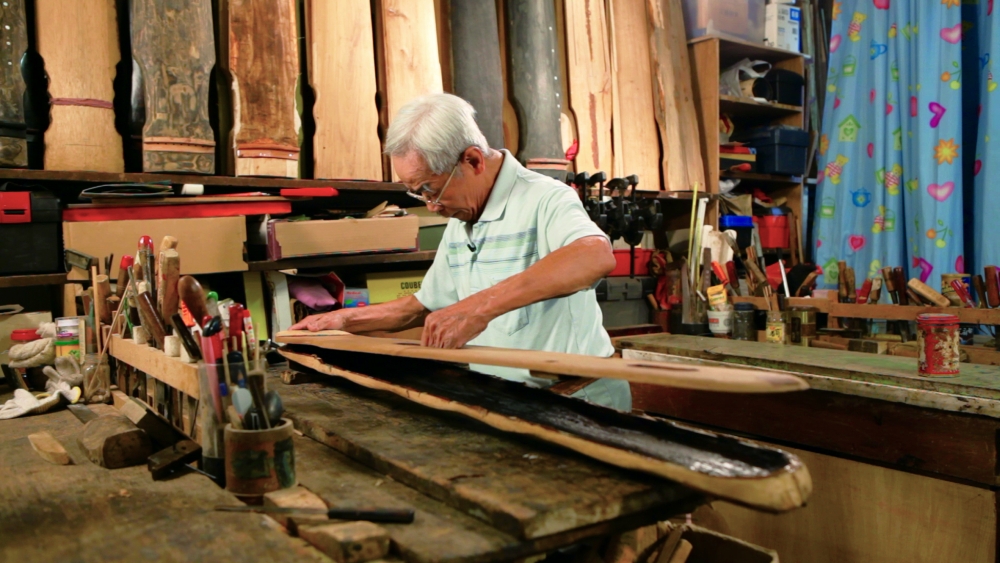
| Date | 2013 |
| People | Choi Chang-sau |
| Material Type | Image |
| Collection | The Legend of Silk and Wood: A Hong Kong Qin Story |
| Source | Intangible Cultural Heritage Office and Hong Kong Heritage Museum |
| Repository | Intangible Cultural Heritage Office |
| Note to Copyright | Permission for use in Hong Kong Memory is given by Intangible Cultural Heritage Office and Hong Kong Heritage Museum |
| Accession No. | lcs-hkqs-0112 |
The fifth step of qin making process: assembling
The chopped and hollowed top board and bottom board can be held together with a mixture of raw lacquer and flour, or with animal gum. After the boards have adhered to each other, a linen cloth can be glued onto and wrapped around the qin body, using an evenly applied layer of a mixture of raw lacquer and flour. This helps tightening the qin body and prevents the lacquer on the qin top from warping and cracking. Another way of assembly is to use bamboo nails to hold the top and bottom boards together at the corners of the forehead, the shoulders, the wings, the waist and the tail. The bamboo nails are inserted from the bottom upward. No adhesive is involved with this method. This photo shows the fifth step of qin making process which was demonstrated by Choi Chang-sau.
| Date | 2013 |
| People | Choi Chang-sau |
| Material Type | Image |
| Collection | The Legend of Silk and Wood: A Hong Kong Qin Story |
| Source | Intangible Cultural Heritage Office and Hong Kong Heritage Museum |
| Repository | Intangible Cultural Heritage Office |
| Note to Copyright | Permission for use in Hong Kong Memory is given by Intangible Cultural Heritage Office and Hong Kong Heritage Museum |
| Accession No. | lcs-hkqs-0112 |
The fifth step of qin making process: assembling
The chopped and hollowed top board and bottom board can be held together with a mixture of raw lacquer and flour, or with animal gum. After the boards have adhered to each other, a linen cloth can be glued onto and wrapped around the qin body, using an evenly applied layer of a mixture of raw lacquer and flour. This helps tightening the qin body and prevents the lacquer on the qin top from warping and cracking. Another way of assembly is to use bamboo nails to hold the top and bottom boards together at the corners of the forehead, the shoulders, the wings, the waist and the tail. The bamboo nails are inserted from the bottom upward. No adhesive is involved with this method. This photo shows the fifth step of qin making process which was demonstrated by Choi Chang-sau.
| Date | 2013 |
| People | Choi Chang-sau |
| Material Type | Image |
| Collection | The Legend of Silk and Wood: A Hong Kong Qin Story |
| Source | Intangible Cultural Heritage Office and Hong Kong Heritage Museum |
| Repository | Intangible Cultural Heritage Office |
| Note to Copyright | Permission for use in Hong Kong Memory is given by Intangible Cultural Heritage Office and Hong Kong Heritage Museum |
| Accession No. | lcs-hkqs-0112 |
The fifth step of qin making process: assembling
The chopped and hollowed top board and bottom board can be held together with a mixture of raw lacquer and flour, or with animal gum. After the boards have adhered to each other, a linen cloth can be glued onto and wrapped around the qin body, using an evenly applied layer of a mixture of raw lacquer and flour. This helps tightening the qin body and prevents the lacquer on the qin top from warping and cracking. Another way of assembly is to use bamboo nails to hold the top and bottom boards together at the corners of the forehead, the shoulders, the wings, the waist and the tail. The bamboo nails are inserted from the bottom upward. No adhesive is involved with this method. This photo shows the fifth step of qin making process which was demonstrated by Choi Chang-sau.
| Date | 2013 |
| People | Choi Chang-sau |
| Material Type | Image |
| Collection | The Legend of Silk and Wood: A Hong Kong Qin Story |
| Source | Intangible Cultural Heritage Office and Hong Kong Heritage Museum |
| Repository | Intangible Cultural Heritage Office |
| Note to Copyright | Permission for use in Hong Kong Memory is given by Intangible Cultural Heritage Office and Hong Kong Heritage Museum |
| Accession No. | lcs-hkqs-0112 |
The fifth step of qin making process: assembling
The chopped and hollowed top board and bottom board can be held together with a mixture of raw lacquer and flour, or with animal gum. After the boards have adhered to each other, a linen cloth can be glued onto and wrapped around the qin body, using an evenly applied layer of a mixture of raw lacquer and flour. This helps tightening the qin body and prevents the lacquer on the qin top from warping and cracking. Another way of assembly is to use bamboo nails to hold the top and bottom boards together at the corners of the forehead, the shoulders, the wings, the waist and the tail. The bamboo nails are inserted from the bottom upward. No adhesive is involved with this method. This photo shows the fifth step of qin making process which was demonstrated by Choi Chang-sau.
| Date | 2013 |
| People | Choi Chang-sau |
| Material Type | Image |
| Collection | The Legend of Silk and Wood: A Hong Kong Qin Story |
| Source | Intangible Cultural Heritage Office and Hong Kong Heritage Museum |
| Repository | Intangible Cultural Heritage Office |
| Note to Copyright | Permission for use in Hong Kong Memory is given by Intangible Cultural Heritage Office and Hong Kong Heritage Museum |
| Accession No. | lcs-hkqs-0112 |
The fifth step of qin making process: assembling
The chopped and hollowed top board and bottom board can be held together with a mixture of raw lacquer and flour, or with animal gum. After the boards have adhered to each other, a linen cloth can be glued onto and wrapped around the qin body, using an evenly applied layer of a mixture of raw lacquer and flour. This helps tightening the qin body and prevents the lacquer on the qin top from warping and cracking. Another way of assembly is to use bamboo nails to hold the top and bottom boards together at the corners of the forehead, the shoulders, the wings, the waist and the tail. The bamboo nails are inserted from the bottom upward. No adhesive is involved with this method. This photo shows the fifth step of qin making process which was demonstrated by Choi Chang-sau.
| Date | 2013 |
| People | Choi Chang-sau |
| Material Type | Image |
| Collection | The Legend of Silk and Wood: A Hong Kong Qin Story |
| Source | Intangible Cultural Heritage Office and Hong Kong Heritage Museum |
| Repository | Intangible Cultural Heritage Office |
| Note to Copyright | Permission for use in Hong Kong Memory is given by Intangible Cultural Heritage Office and Hong Kong Heritage Museum |
| Accession No. | lcs-hkqs-0112 |
The fifth step of qin making process: assembling
The chopped and hollowed top board and bottom board can be held together with a mixture of raw lacquer and flour, or with animal gum. After the boards have adhered to each other, a linen cloth can be glued onto and wrapped around the qin body, using an evenly applied layer of a mixture of raw lacquer and flour. This helps tightening the qin body and prevents the lacquer on the qin top from warping and cracking. Another way of assembly is to use bamboo nails to hold the top and bottom boards together at the corners of the forehead, the shoulders, the wings, the waist and the tail. The bamboo nails are inserted from the bottom upward. No adhesive is involved with this method. This photo shows the fifth step of qin making process which was demonstrated by Choi Chang-sau.
| Date | 2013 |
| People | Choi Chang-sau |
| Material Type | Image |
| Collection | The Legend of Silk and Wood: A Hong Kong Qin Story |
| Source | Intangible Cultural Heritage Office and Hong Kong Heritage Museum |
| Repository | Intangible Cultural Heritage Office |
| Note to Copyright | Permission for use in Hong Kong Memory is given by Intangible Cultural Heritage Office and Hong Kong Heritage Museum |
| Accession No. | lcs-hkqs-0112 |
The fifth step of qin making process: assembling
The chopped and hollowed top board and bottom board can be held together with a mixture of raw lacquer and flour, or with animal gum. After the boards have adhered to each other, a linen cloth can be glued onto and wrapped around the qin body, using an evenly applied layer of a mixture of raw lacquer and flour. This helps tightening the qin body and prevents the lacquer on the qin top from warping and cracking. Another way of assembly is to use bamboo nails to hold the top and bottom boards together at the corners of the forehead, the shoulders, the wings, the waist and the tail. The bamboo nails are inserted from the bottom upward. No adhesive is involved with this method. This photo shows the fifth step of qin making process which was demonstrated by Choi Chang-sau.
| Date of Death | 2013 |
| People | Choi Chang-sau |
| Material Type | Image |
| Collection | The Legend of Silk and Wood: A Hong Kong Qin Story |
| Source | Intangible Cultural Heritage Office and Hong Kong Heritage Museum |
| Repository | Intangible Cultural Heritage Office |
| Note to Copyright | Permission for use in Hong Kong Memory is given by Intangible Cultural Heritage Office and Hong Kong Heritage Museum |
| Accession No. | lcs-hkqs-0112 |
The fifth step of qin making process: assembling
The chopped and hollowed top board and bottom board can be held together with a mixture of raw lacquer and flour, or with animal gum. After the boards have adhered to each other, a linen cloth can be glued onto and wrapped around the qin body, using an evenly applied layer of a mixture of raw lacquer and flour. This helps tightening the qin body and prevents the lacquer on the qin top from warping and cracking. Another way of assembly is to use bamboo nails to hold the top and bottom boards together at the corners of the forehead, the shoulders, the wings, the waist and the tail. The bamboo nails are inserted from the bottom upward. No adhesive is involved with this method. This photo shows the fifth step of qin making process which was demonstrated by Choi Chang-sau.
| Date | 2013 |
| Material Type | Image |
| Collection | The Legend of Silk and Wood: A Hong Kong Qin Story |
| Source | Intangible Cultural Heritage Office and Hong Kong Heritage Museum |
| Note to Copyright | Permission for use in Hong Kong Memory is given by Intangible Cultural Heritage Office and Hong Kong Heritage Museum |
| Accession No. | lcs-hkqs-0112 |
The fifth step of qin making process: assembling
The chopped and hollowed top board and bottom board can be held together with a mixture of raw lacquer and flour, or with animal gum. After the boards have adhered to each other, a linen cloth can be glued onto and wrapped around the qin body, using an evenly applied layer of a mixture of raw lacquer and flour. This helps tightening the qin body and prevents the lacquer on the qin top from warping and cracking. Another way of assembly is to use bamboo nails to hold the top and bottom boards together at the corners of the forehead, the shoulders, the wings, the waist and the tail. The bamboo nails are inserted from the bottom upward. No adhesive is involved with this method. This photo shows the fifth step of qin making process which was demonstrated by Choi Chang-sau.
| Date | 2013 |
| Material Type | Image |
| People | Choi Chang-sau |
| Collection | The Legend of Silk and Wood: A Hong Kong Qin Story |
| Source | Intangible Cultural Heritage Office and Hong Kong Heritage Museum |
| Repository | Intangible Cultural Heritage Office |
| Note to Copyright | Permission for use in Hong Kong Memory is given by Intangible Cultural Heritage Office and Hong Kong Heritage Museum |
| Accession No. | lcs-hkqs-0112 |
Copyright © 2012 Hong Kong Memory


